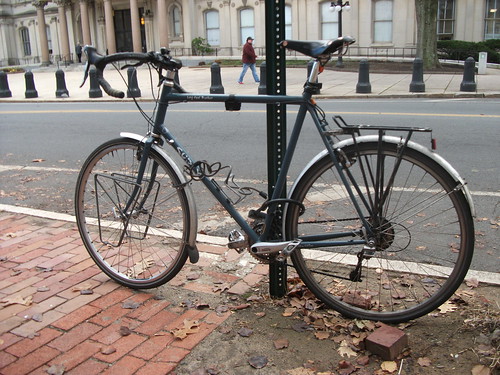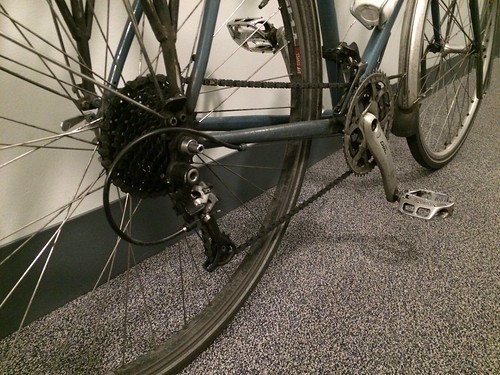As I wheeled my bike along 58th Street in midtown Manhattan in a heavy rain
shower last Wednesday, I noticed a periodic scraping sound from the vicinity of
my rear brakes. Realising that one of the brake pads was rubbing a slight bump
in the wheel, I delved into one of my pannier bags, pulled out a multi-tool and
set to work. I marginally tightened the left-hand brake calliper and loosened
the right-hand one about the same. I was pleasantly surprised to hear the sound
had stopped and that, when I started riding down Lexington Avenue , the brakes were working
as well as they ever do in the slitheriness of a spring downpour.
 |
| Shaped by 30,000 miles' riding: my Surly Long Haul Trucker mediates many of my interactions with the world. |
The incident made me realise how, even though I still
regularly make comically silly mistakes when trying to maintain my bike, I’ve come to know its ways. My attempts to fix faults are growing steadily less
disastrous. It also made me think, harder than I have for a while, about quite
how intense and symbiotic the relationship between a regular cyclist and his or
her main bike can be. My body has gradually shaped this bike – on which I’ve
ridden about 30,000 miles over seven years – to fit its needs. I’ve steadily
fitted tougher and tougher rear hubs after cheaper ones collapsed under the
strain of hauling my tall, heavy body away from traffic lights. The bike,
meanwhile, has shaped my body. My bulging leg muscles testify to hundreds of
twice-daily climbs over the Brooklyn and Manhattan Bridges
 |
| My Phil Wood rear hub: a component so expensive one buys it only after breaking every other brand available. |
It’s because of this intense symbiosis, I think, that for
many cyclists their main bike excites far greater passion than its status as a
possession should suggest. A bike becomes one’s own more and more over time,
much as a pair of shoes does. My Surly Long Haul Trucker probably shapes how I
interact with the world more than any possession except my spectacles.
It’s hardly surprising that, even more than dogs, bikes seem to start taking on
an appearance similar to their owners’.
My midtown incident also, however, threw my mind back to the
Thursday before Easter, when I encountered a High School student struggling
with his bike on the Hudson River Greenway. He asked me to lend him a pump to
inflate his obviously punctured rear tyre. Recognising that mere extra pumping
wouldn’t get the young man all the way home to Williamsburg , I fixed the puncture for him. But
I also felt grateful for the years of advice and training from my father, bike
shop staff and fellow cyclists that ensure I’m never similarly forced to rely
on the kindness of cycling strangers.
The downside, after all, of the elegant simplicity of a
bicycle’s workings is that simple often isn’t self-explanatory. In an era when
carmakers are warning customers that they shouldn’t on any account try to
repair their vehicles because of the sophistication of their software and electronics,
most bikes remain resolutely mechanical. They are still controlled by systems
of levers and springs, actions balanced against equal and opposite reactions.
It requires some understanding of derailleur gears to grasp,
however, that the cable for the rear sprockets needs to be tighter if the bike
isn’t shifting easily onto the easiest gears. When I undertook my roadside
repair last Wednesday, I was tensioning the spring in the left calliper and
loosening the spring in the right one. I was using my knowledge and experience
of how the two sides of the brakes push against each other.
It’s not only worth understanding these systems for purely
practical reasons. There’s a poetry to the way a rear mechanism pushes a chain
between the sprockets of a derailleur gear that is a powerful testimony to
human ingenuity. It’s compelling evidence of how humans learn from their
predecessors and make progress that I can now so easily adjust my brakes thanks
to simple adjustment mechanisms. That was impossible with the bikes I owned 20
years ago.
The sheer range of different ways of making a bike work also
testifies to the dazzling range of different things people seek to do with
bikes. I ride a bike with plenty of gears and a solid frame because it fits
with the relationship I want between my body and the bike. When I had bikes
with harder-to-change gears, I used to get sore knees from pushing on the
pedals in a less-than-efficient gear. I shift gears hundreds of times every
journey now and my knees suffer no longer. The frame of one old, alloy bike
broke under me. My steel frame has withstood the stresses of one crash with a car, another with another bike, huge loads of weekly shopping and transporting,
at different times, both my children. I marvel at how smoothly the steel frame
copes with corners, removing the sense that I’m wrestling with the bike to get
it to turn.
The range of different balances between body and bike came
home to me on Saturday night when the Invisible Visible family and I headed the
short distance from our apartment to the Red Hook Criterium, a cycling road
race near our apartment. The race compels riders to use track bikes – light, brakeless
and with fixed wheels – rather than more conventional, multi-geared road bikes.
The trade-off was plain. The event teemed with cyclists with leaner, stronger,
more efficient bodies than mine, honed to handle the rigours of a far less
forgiving bike. We watched awestruck as these hyper-fit riders and their stripped-down machines negotiated the 1.25km circuit, ticking off
some laps in less than 90 seconds and swishing by us at well over 60kph.
I’ll never zip round a track like these fit young
men. Nor will I ever dance up Alpe d’Huez like Chris Froome, except in my imagination. But there is a similar
satisfaction in the relationship between our bodies and the machines. For the Criterium riders, Tour de France participants and me, the bicycle magnifies our bodies’ efforts. For the Criterium riders,
it was a question of a carbon frame's coping with the strain both of rapid acceleration and of being slowed down
for a corner only through the rider’s resistance against the pedals’ spinning. My bike has to absorb the shock of a hidden pothole then let me skip swiftly away from the next
traffic lights while the drivers are still looking at their smartphones.
 |
Riders fly by at the Red Hook Crit: yes,
it's entirely different
from my cycling but, yes, their bikes offer
similar joys.
|
Even for me, being on a bike can resemble being in possession of a superpower. On an empty, flat road, it can feel
when I slip the chain onto the biggest, fastest chainring as if I’m Mr Scott
pushing the button to send the Starship Enterprise into warp drive. A range of
new, higher speeds is suddenly at my command and my speed surges. As I labour
up steep hills, meanwhile, I reach the lower limits of the lowest gears on my
middle chainring. Then I feel a little surge of joy as I switch down to my
smallest chainring, pedalling grows easier and nearly any slope is within my
reach.
It’s on the offchance that I’ll enjoy such a feeling that I
ride to work when I can even on days when the water in my bottle freezes on the way to work – and on days so hot the whole city stinks. Maybe in time the same feeling will inspire the young man I helped to persevere with cycling rather than giving
up in frustration. I'd love to think that one day he'd join me among a fairly small minority of New Yorkers - the ones who, faced with rain and
a faulty bike, say not, “Let’s take the subway,” but, “Where in my bag is that
multi-tool?”



Nothing beats the feeling of rider and bike working as one - I love the (few) days when pedalling seems to effortlessly propel me along.
ReplyDeleteOf course, combining this with beautiful spring sunshine, lambs and moorhen chicks, as I managed today, and one almost enjoys having to work just for the excuse of going for another ride!
Thanks for writing your blog by the way. Since discovering it last year, I always look forward to your new posts. You're one of the few bloggers that I can both relate to and who makes me think about life/riding in different ways.
Regards
Ijon
Ijon,
DeleteThank you for your kind words. You're right about the act of pedalling along on a good day - and, while it's hard to reach lambs and moorhen chicks from New York City, I know such bucolic scenes can add to the joy.
All the best,
Invisible.
Personally, I think adjustments were easier back in the day. Nowadays, SRAM, Campy, and Shimano dérailleur components are all incompatible. My old bikes freely mix and match.
ReplyDeleteSteve A,
DeleteI think this probably reflects our different skill levels. I don't aspire to much more than ensuring my brakes don't rub and my gears change roughly as I ask them to. I'm pretty confident it's got easier to arrange that in recent years. I leave my local bike shop, I'm afraid, to worry about issues such as the intercompatibility of different component types.
One thought that occurs to me, however, is that it's perhaps an inevitable outcome of components' becoming more user-friendly that they become more sophisticated and the scope for different brands to approach the issues differently grows.
All the best,
Invisible.
if you have such bulging leg muscles, then why do you ride a triple?
ReplyDelete